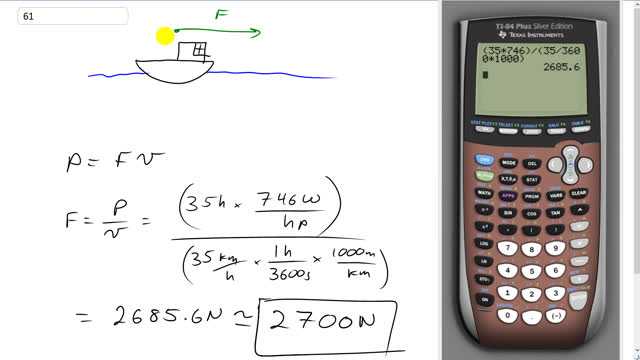
An outboard motor for a boat is rated at 35 hp. If it can move a particular boat at a steady speed of 35 km/h, what is the total force resisting the motion of the boat?

In order to watch this solution you need to have a subscription.
This is Giancoli Answers with Mr. Dychko. The power of the motor in the boat is equal to its force times the speed of the boat and that force is directed to the right, in the same direction of velocity, say. So this is the force of the boat. And in the opposite direction, we have the force due to the water on the boat. So this is force due to the water; the hydrodynamic friction. And these forces will be the same size because the boat's not accelerating. And so we have this formula here for power exerted by the engines of the boat equals the force exerted by the engines times the boat's velocity. But this force of the boat is gonna be the same as force of the water; the force of the water is what we have to find and since these forces are the same, we can just you know, we don't need to put any subscript here; b for boat or w for water because as we were just saying here, force of the water equals force of the boat so let's just call it force. There. So, power is force times velocity and we'll divide both sides by velocity and that makes force equal to power divided by velocity. And we have to do some unit conversion work here; so we have 35 horsepower of the boat engine and times that by 746 watts per horsepower giving us watts on the top because we have to convert everything into meters, kilograms and seconds type units; watts, falls into this category because it's, you know, we could take it down to these base meters, kilograms and seconds units, if we wanted to; we could say, watts is newtons times meters per second and then newtons is kilograms times meters per second squared because it's mass times acceleration to get the force but anyway, let's not get too complicated. So, we have watts on the top and we need meters per second on the bottom. So, we have 35 kilometers per hour, speed of the boat, times by 1 hour for every 3600 seconds times 1000 meters per kilometer gives us meters per second on the denominator here. And we end up with 2685.6 newtons, which we'll round to two significant figures - 2700 newtons must be the force exerted by the drag of the water and that's a force in the opposite direction of the velocity.